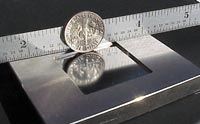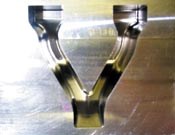Silicon Powder Additives Proven Safe And Effective In EDM
As with any new EDM innovation, the effectiveness of various powder finish processes will be debated. Likewise, dual-tank systems will be compared to single-tank systems. Here's a viable answer to that debate.
Innovations in additive technology allow shops to produce fine finishes without the hassle of polishing. Standard EDM matte and highly reflective, glossy, mirror finishes are available from the same machine. But as with any new innovation, the effectiveness of various powder finish processes will be debated. Likewise, dual-tank systems will be compared to single-tank systems.
Mitsubishi EDM’s entry in the additive process marketplace is represented by its EPX Series of ram (sinker) EDM models. Currently, the series includes two models, the EPX22 and the EPX30. The dual tanks on these machines allow conventional machining on the standard oil side and silicon powder operation on the slurry side. Large, rough burn contaminants are isolated from the mix, increasing the life of the finishing fluid. The EPX22 accepts workpieces as large as 900 mm wide, 600 mm deep, and 300 mm tall; while the larger EPX30 accepts workpieces 1100, 700, and 350 mm respectively.
The system works with the silicon powder in suspension as larger spark energy is discharged from the electrode striking a powder particle within the gap and dispersing this energy to produce a very uniform finish. However, in order to fully understand the benefits of powder EDM, certain myths must be cleared up. Silicon is a non-toxic, natural element found commonly in nature. Refined into a metallic silicon material, it is used as a semi-conductor in computer microchips. Taking that material and grinding it to a fine powder creates the additive for the silicon powder finishing process. This silicon powder contains no chrome, which is a toxic, heavy metal, nor any other unsafe material. According to the company, every venue implicated by this process has been explored in order to be certain of its safety. The research of perfecting the use of silicon powder in this EDM finishing process has progressed for over a decade, the company says.
Developers point out that if a manufacturer uses a powder additive in a single-tank system, common paper filters cannot be used because they would filter out the powder additive. Magnetic separators are often employed instead, but that limits them to burning only magnetic materials. That means that today’s many alloyed materials, along with aluminum, titanium and carbide, could not be burned on such single-tank systems.
Mitsubishi EDM’s two-tank system is designed for more flexibility since the standard dielectric oil and the powder finishing material are in separate tanks. Once the part has been completed using standard oil (down to a 6 Rmax finish), the machine automatically switches over to the powder oil side for the final power setting that produces the highly reflective, glossy, mirror finish. Very little powder is consumed, the company says, because it is only used for the final setting during which only 0.0001 inch to 0.0002 inch of the workpiece material is removed.
There is no possibility that silicon powder will settle or clump in the work tank of EPX machines because a high-speed tank circulation system, along with the Fuzzy Pro 2 jump strategy and orbit cycles, eliminates powder separation from the oil. This process produces a very uniform finish to both sidewalls and the cavity bottom.
Machining with a powder additive reduces the need for tedious hand polishing. This can be accomplished with either type of powder process. However, the dual-tank system creates an even greater cost savings since standard, filtered oil is used for the majority of the machining process. According to developers, the total cost of this type of powder operation shows a 68 percent savings when compared to single-tank systems. Having a dual-tank system allows for a greater range of machining possibilities since not all jobs require the ultimate in EDM surface finishes. A dual-tank machine is available for non-magnetic jobs that may require an average, matte EDM finish that can be processed and completed without wasting the powder additive. It is pointed out that the second tank can be run like an air conditioner, to be switched on and off as the situation requires.
Computer technology has benefited all areas of EDM machining, and the dual-tank powder finishing system is no exception. Programming is as simple and easy as it is on non-additive systems. The Fuzzy Pro 2 Control emulates an experienced operator, automating the process. There is no re-programming or manual intervention involved during the machining process because the system is designed to automatically switch from one tank to the next.
Collectively, the innovations in the EDM industry are promising. When looked upon generally, it is clear that powder finishing can dramatically improve productivity in many mold shops by virtually eliminating hand polishing of mirror finishes.
Click here to learn more about supplier MC Machinery Systems, Inc..
Related Content
Choosing The Right Grinding Wheel
Understanding grinding wheel fundamentals will help you choose the right wheel for the job.
Read MoreA New Milling 101: Milling Forces and Formulas
The forces involved in the milling process can be quantified, thus allowing mathematical tools to predict and control these forces. Formulas for calculating these forces accurately make it possible to optimize the quality of milling operations.
Read MoreHow to Start a Swiss Machining Department From Scratch
When Shamrock Precision needed to cut production time of its bread-and-butter parts in half, it turned to a new type of machine tool and a new CAM system. Here’s how the company succeeded, despite the newness of it all.
Read More10 Things to Know About Creep-Feed Grinding
Because of the high material removal rate creep-feed grinding can deliver in challenging materials, grinding might not be just the last step in the process—it might be the process.
Read MoreRead Next
The Cut Scene: The Finer Details of Large-Format Machining
Small details and features can have an outsized impact on large parts, such as Barbco’s collapsible utility drill head.
Read More3 Mistakes That Cause CNC Programs to Fail
Despite enhancements to manufacturing technology, there are still issues today that can cause programs to fail. These failures can cause lost time, scrapped parts, damaged machines and even injured operators.
Read More









.png;maxWidth=300;quality=90)



.png;maxWidth=300;quality=90)













